Culture and Sustainability Symposium 2022
Culture & Sustainability - Symposium
6th Edition
November 12 & 13, 2022 | Lisboa Incomum
About
The “Culture and Sustainability Symposium" is co-organized annually by Lisboa Incomum and Project DME. Counting five editions since 2017 (the opening year of Lisboa Incomum, a space dedicated to electroacoustic music), it aims to foster an interdisciplinary discussion (artistic, scientific, political) on the roles that artistic practices can assume for environmental awareness, intervening in the discussion on topics such as sustainability and ecology. This discussion is held between the public and the event's guests through different types of activities such as conferences, concerts and workshops.
This year's edition is also co-organized by CCMAR - Centro de Ciências do Mar from Algarve University.
All the symposium activities will be held in English and participation requires registration at:
Attendance at conferences and concerts is free, but registration is required.
Attendance at the 2 workshops costs 5€ each. Registration is also required and in case registration is made to all 2 workshops, then the total cost is 8€. Our team will get in touch to proceed with payment once we receive the registration.
Program
[full info on the activities below]
November 12th, 2022
4:30 pm - 5:30 pm
Workshop
with Isabel Barrote (CCMAR, Portugal)
Max. number of participants: 10
6 pm - 7 pm
Conferences
with Ana Matias, Deborah Power and Paulo Martel (researchers at CCMAR/Universidade do Algarve, Portugal)
7:30 pm - 8:30 pm
Concert · Acousmatic Music & Sustainability
November 13th, 2022
3:00 pm - 5:30 pm
Workshop
with Eléonore Bak (CRESSON, France)
Max. number of participants: 10
6 pm -7 pm
Conferences
with Eléonore Bak (Centre de Recherche sur l’Espace Sonore et l’environnement urbain - CRESSON, France), Astrid Rieder (visual artist, Austria) and Ricardo Almeida (Lisbon College of Music - ESML, Portugal)
7:30 pm - 8:30 pm
Multidisciplinary Concert
Eco-Lab from ESML, Abdul Moimême and Astrid Rieder
Permanent exhibition
Carlos Caires' installation "Lugares invisíveis" (Invisible places), in collaboration with photographer Sofia Nunes, will be in permanent exhibition at Lisboa Incomum during the symposium.
November 12th
4:30 pm - 5:30 pm
Workshop with Isabel Barrote (CCMAR, Portugal)
Plants do things differently
Plants dominate Planet Earth, and this can be easily observed in our everyday life. Albeit we, humans, spend all our lives side to side with plants, we barely consider them as living beings, almost completely ignore them, and hardly question ourselves about who or what they are or do. However, plants are as alive as we are, and without them, little life would be possible as we know it. They just do things differently.
Participants will be invited to interact with plants and learn from their reactions in real time to different environments.
Price per person: 5€
6 pm - 7 pm
Conferences with Ana Matias, Deborah Power and Paulo Martel (researchers at CCMAR/Universidade do Algarve, Portugal)
Current food production systems, largely based on conventional terrestrial farming are resource constrained and will not match the demand for food by the burgeoning world population in coming decades. Furthermore, the world has entered a destructive cycle in which exploitation of natural resources is driving climate change with devastating consequences for equitable provision of nutritious, secure, and affordable food. Exploitation of aquatic ecosystems that cover approximately 75% of the planet’s surface can yield a paradigm shift in food-systems as production is still growing faster than the global population. A second action that has to accompany any shift in food production models is linked to food loss and waste, which is a staggering 1.3 billion tons per year. In as little as 30 years the world population will reach 9.7 billion people and there is an urgent need to change the food paradox by leveraging a global cultural shift in the perception of food and waste. There is an opportunity during the shift in food-systems for actions promoting respect of ecosystems and promoting their recovery and health. The science and socio-economic indicators have already identified the challenges and are mapping out and testing potential solutions. However, it is urgent to engage all stakeholders and make them part of the solution for the food-waste paradigm. This needs holistic actions that communicate the key messages directly and indirectly to the public and lay-out the now, and future scenarios depending on the route selected. This is a global issue, it is here to stay, and clear messages placed in an appropriate cultural context are a priority and have to come from all domains in society, science, culture, arts, politics etc to shift societal and public perception and drive change. I aim to place the challenge in context and then consider why a holistic approach integrating culture and arts is crucial.
Acknowledgements: DMP is supported in part by Portuguese national funds from FCT - Foundation for Science and Technology through project UIDB/04326/2020, UIDP/04326/2020 and LA/P/0101/2020, and from the operational programmes CRESC Algarve 2020 and COMPETE 2020 through project EMBRC.PT ALG-01-0145-FEDER-022121.Biological macromolecules are the machinery of living cells, by means of which all life processes are enabled. They form complex structures that can be whimsically irregular or beautifully symmetric. Visualization of these structures by means of computer 3D graphics is a tool of the utmost importance for understanding the molecular mechanisms of life. At the same time, these depictions can be aesthetically very pleasing, science and visual art going hand in hand to provide the maximum effect. These points will be illustrated in a non-technical way, with a variety of examples showing how 3D molecular visualization can offer an experience that is both visually and scientifically rewarding.
In this work we undertook a systematic review of the scientific literature about the role of art (or artistic practices) in coastal and marine sustainability. We searched the two most important scientific databases of articles (Scopus and Web of Science) about sustainability, coast and marine topics, and retrieved a total of 1352 articles that included related key-words. Article’s abstract and title were screened to select the 110 illegible items for our study. After reading the full text, we identified 80 studies that actually address our question - Is there scientific evidence of the role of art in coastal and marine sustainability?
The filtered articles describe a variety of artworks, such as photography, poetry, comics, performances, or installation, from artists, local communities, researchers and institutions around the world. According to our prevalence analysis of the descriptions/analysis/experiments carried out by the authors of these publications, the most frequent role that art play - or is supposed to play - is to engage various audiences on issues related to sustainability, in particular those related to climate change.
Ana Matias1, Ana Rita Carrasco1, Bruno Pinto2, Jaime Reis3
(1) Centro de Investigação Marinha e Ambiental (CIMA), Universidade do Algarve.
(2) Centro de Ciências do Mar e do Ambiente (MARE), Universidade de Lisboa.
(3) ESML / IPL - Escola Superior de Música de Lisboa, Instituto Politécnico de Lisboa, IDI&CA; ESART / IPCB - Escola Superior de Artes Aplicadas, Instituto Politécnico de Castelo Branco; INET-md / FCSH-UNL - Instituto de Etnomusicologia - Centro de Estudos de Música e Dança da Faculdade de Ciências Sociais e Humanas da Universidade Nova de Lisboa
7:30 pm - 8:30 pm
Concert · Acousmatic Music & Sustainability
Francis Dhomont (composition) and Inés Wickmann (conception and image) - Tropismes
Natasha Barrett - Microclimate II: Red Snow
Ingrid Drese (composition) and Inés Wickmann (conception and image) - Engloutissement
Alex Buck - A Revolta dos Xapiris
Elainie Lillios (composition) and Bonnie Mitchell (animation) - Paradigm Shift
Program Notes:
Francis Dhomont (composition) and Inés Wickmann (conception and image) - Tropismes
Image and Conception: Inés Wickmann
Music: Francis Dhomont
© 2019 Adagp / Sacem
Nature throbs, harassed by the aggression we impose on it. "Any technological progress generates a loss on another plane", writes Claude Lévi Strauss. Plant movements are a form of tropism, a reaction to conflict with the strange materials that invade their world.
Natasha Barrett - Microclimate II: Red Snow
Red Snow is snow coloured rose to blood red by a growth of algae or diatoms. During seasons when there is little sunlight and temperatures are much lower than the freezing point, the algae are dormant.
I moved to Norway in January - the middle of winter. Both the meteorological and geographical climate dramatically contrasted that found in England. Through leaving friends and places I knew so well, I felt increasingly aware of my current environment. The variety of snow spiralling in the wind, blurring my vision; the cold; the intricate details of vegetation enhanced by a layer of crystal formations; the brightness after the snow ceases to fall; tiny ice crystals falling from branches disturbed by wildlife; footprints suggesting their own scenario... and the potential colour - lying dormant.
Red Snow is the second in a series of works entitled 'microclimates'. Each work is structurally balanced, not in a symmetrical sense, but through the 'life' of one articulation resulting in a subsequent and counterbalancing reaction. I have attempted to concentrate the beauty and violence of a natural landscape into the 'microclimate' of the work - forming a new 'organisational space' yet reflecting, in acoustic form, the natural world and source inspiration.
Ingrid Drese (composition) and Inés Wickmann (conception and image) - Engloutissement
Image and Conception: Inés Wickmann
Music: Ingrid Drese
© 2022 Adagp, Sacem
Pal - 16 / 9- 1920x1080
QT H264
Engloutissement
Notre fête est finie, engloutie, envahie, lentement anéantie.
Ici, la musique a précédé l’image qui s’en inspire.
Alex Buck - A Revolta dos Xapiris
This piece was composed during the pandemic while I was doing my PhD and residing in the United States. I followed at a distance the news of the widespread dismantling of the structures for monitoring and defending the native peoples and their forests in Brazil. Astonished and completely impotent, I composed this work guided by an internal revolt against the project of annihilation to the indigenous communities and burning of forests promoted by the fascist government of Jair Messias Bolsonaro. At that time (2020), coincidentally, I was reading "The Fall of the Sky," a joint work between Davi Kopenawa, one of the most important Yanomami leaders, and his friend, the ethnologist Bruce Alpert. In this book, Kopenawa details the Yanomami way of life and values by critically contrasting them with the "white man's" way of life.
Delving a bit into the creative process of the piece, the composition is highly abstract and does not follow any linear narrative. However, I intentionally make use of sounds from our daily lives, recognizable, that can work as triggers for free associations to the theme. Another important detail is that, with the piece already well underway, I felt I needed material that alluded more concretely and unequivocally to the universe of native peoples. That was when I started an internet search and came across an audio recording of a shamanic ritual conducted by David Kopenawa himself (recording kindly provided by Marcos Wesley). I selected parts of Kopenawa's voice that permeate the entire piece. Luckily, the voice of the shaman not only matched the previously composed material, but also gave the piece a new meaning: that of amplifying and making the "white man" listen to Kopenawa's voice.
Finally, I leave an excerpt from the book that inspired the title of the piece and acted as a latent atmosphere throughout the composition: "... For us, the xapiri are the true owners of "nature," not human beings. The xapiri continuously walk all over the forest without us knowing [...]. These are words that the white people do not understand. They think forests are dead and empty, that nature is out there for no reason, and that it is mute. They don’t want to listen to either our’s or spirit’s words. They prefer deafness. [...] “...The forest is alive. It can only die if white people persist in destroying it. If they succeed, the rivers will disappear underground, the soil will crumble, the trees will shrivel up, and the stones will crack in the heat. The dried-up earth will become empty and silent. The xapiri spirits who come down from the mountains to play on their mirrors in the forest will escape far away. Their shaman fathers will no longer be able to call them and make them dance to protect us. They will be powerless to repel the epidemic fumes which devour us. They will no longer be able to hold back the evil beings who will turn the forest to chaos. We will die one after the other, the white people as well as us. All the shamans will nally perish. Then, if none of them survive to hold it up, the sky will fall."
Elainie Lillios (composition) and Bonnie Mitchell (animation) - Paradigm Shift
Paradigm Shift abstractly represents the fluctuating progression of change that governs social, cultural, and environmental systems. Every so often a radical alteration to the basic fabric of existing structures and beliefs ushers in a new way of thinking. These changes sometimes evolve from pre-existing principles, practices, or complex systems that perturb and ultimately replace them. Other times they appear suddenly out of nowhere and drastically upset the fundamental essence of being. The circumstances that precipitate these radical alterations are often invisible until the shift is recognized, while other times they are expected outcomes of innovation and growth. This animation brings the audience on a journey through these disruptive intrusions and peaceful passages in a quest to reveal the beauty of change.
--------------------------------------------------------------------------------------------------------------------------------
November 13th
3:00 pm - 5:30 pm
Workshop with Eléonore Bak (CRESSON, France)
Mare incognita - Conservation and sustainable use of the oceans
History of oceans has been full of fearful legends. The sailor’s perception and consciousness were prepared to meet loneliness, tempests, devilish monsters climbing up from obscure deepness: iron thoughts sailed out at evening on iron ships (Malcolm Lowry). Until 1850 abysses were considered as completely empty of any live forms.
Today we explore and try to dominate the oceans with machines to drag sand, petroleum and other earth treasures, with cables for telecommunication, submarines for scientific research or for war aims and espionage. We assist on the birth of new territories, species and resources through echo sounders and under water pictures.
We recognize the inner and absolute relationship between ocean and weather; we study the urgently question of what to do with the seventh continent (done by plastic pollution), with human rights, especially in the actual context of climatic or political immigration.
We expect also for the best surf spots with the highest and longest vague.
Oceans continue to feed us, even in a intellectual and spiritual way. Milieu, symbol of infinity, eternity, power, beauty, but also dangerousness and uncontrollability, oceans stir up our curiosity, greed, fantasy, piracy and terror.
The “Challenger Deep”, Mariana Trench, seems be the deepest place of the world ( 10.994 m : last cartography in 2012). Deep sliding, slipping grounds, which house slowly falling beings (alive or died), plunging or climbing waters looks like traps of the descent and vertical catastrophes. The dilution of toxic, indestructible or slowly degradable materials, looks like definitely (even if gradual) dilapidation of nature and as a kind of anticipated experience of the end of the world[1].
Can we come to another perception or scenario?
Oceanic feeling, term inspired by the example of Ramakrishnan among other mystics, which Romain Rolland used in a letter to Sigmund Freud in 1927 and which means later for Freud 1) being one with the external world as a whole, 2) feeling alone even if one renounces every belief and every illusion, (Future of an illusion 1927 and Civilization and its Discontents, 1929), will be the base and fabric of my conference (I) and workshop (II).
Scubas workshop: I propose to interact with two of my earpieces, especially for finding out the frequencies and pendulum of a background noise, of a specific space or an ambiance, but also to find out, to restore and discuss the lost oceans in our body, in our memory, in a painting ... and to identify the resonance and resack of them in our every day life. We will identify kinetic patterns and why not, construct some kind of concerned ambiance, soundscape, music.
Price per person: 5€
6 pm - 7 pm
Conferences with Eléonore Bak (Centre de Recherche sur l’Espace Sonore et l’environnement urbain - CRESSON, France), Astrid Rieder (visual artist, Austria) and Ricardo Almeida (Lisbon College of Music - ESML, Portugal)
I will explain my last artistic work and in parallel I will remember an experience done during my childhood: the singing, vibrating shellfish.
According to a present thinking on invisible landscape, which is for me a reservoir for new gestures and perceptions (physical and aesthetic ones), the big resonators propose to plunge into and not to have a frontal view on this landscape.
The presentation shows a work, which has been realized in the monastery garden of Chappelle de L'Observance in Draguignan. I analyzed first the given sound phenomenons. I was particularly interested by invisible water running, but also wind corridors, echo creating architecture and asymmetric building ( the monastery has become partially private; the half promenade is closed by filling architectural mass). The characteristic sound phenomenons of the monasteries garden consist on a whole repertoire of frequencies and undulations, which I have perceived and later translated by sculpture in the aim of making them perceivable.
trans-Art: "one plus one more than two?" - Astrid Rieder
One speaks of trans-Art when the boundaries of an art genre are transcended and there is an interweaving with other art forms or even sciences. The term is so new that there are already universities, but as I searched for it in early October in the much-frequented online encyclopedia Wikipedia, there is still no entry on the term trans-Art.
The trans-Art division I have developed since 1993 focuses on the synergy of audiovisual artistic collaboration. The main focus is on the dialogue of art genres and the opening of tradition-conditioned, encrusted art-immanent barriers.
In this performative work, an improviser or composer of contemporary music and I communicate with abstract drawing and painting without any given theme, without rehearsals, absolutely spontaneously and directly reacting to each other! Thereby the artistic new creation named by me Composition graphique musicale develops.
The focus is on a continuously interactively modulating dialogue during the trans-art performance, which is led by the protagonists with their respective available stylistic means.
It is especially important to me to present the development of the Composition graphique musicale. Therefore there are video and sound documents about all trans-Art performances. Only in this way can the dialogue underlying the work remain comprehensible.
This concept of interweaving contemporary music and abstract drawing is understandably not so clearly and unambiguously interpretable, which in turn allows the recipient endless possibilities for personal reflection. For me, in the connection of the two very different art genres lies a definite deepening of perception, which I would like to describe in the effect of "one plus one is more than two".
The Interaction "Human-Nature" as a Musical Instrument - Ricardo Almeida
Human beings, from the very beginning of their development, act in a process of transformation of the natural environment in which they live. However, nature, in all its states, also has an enormous influence on the vitality of human beings. This complex relationship can assume a destructive or symbiotic character.
Based on this principle I conceived the piece "Eve is Missing", where I intend to explore the different particularities of this phenomenon. In this piece an electronic system is used that objectively reflects this interaction, through the measurement of electric current transmitted by the performer and mediated by a plant. This plant is seated in a vase purposely built for the control of electroacoustic music.
The sonic result is then influenced by a human variable (coming from the performer) allied to a natural variable (the physical conditions of the plant at the moment of performance).
Multidisciplinary Concert
Eco-Lab from Laboratório de Música Mista, ESML + Abdul Moimême and Astrid Rieder
Cristóvão Almeida, Débora Coquim and Fábio Chicotio - Paisagem Sonora
Ricardo Almeida - Eve is Missing
Débora Coquim - Forêt
Abdul Moimême and Astrid Rieder - Improvisation
Cristóvão Almeida, Débora Coquim and Fábio Chicotio - Paisagem Sonora
As the typology of the title shows, this work focuses on the sound transposition of the environment that surrounds us. In this sound work, we try to materialize the industrial revolution, which led us to the present day, as well as the improvements and consequences that these have brought. In this way, we replicate this technological evolution, through sounds and environments recognizable by most human beings, leaving a sound idea that: There is still time to improve the situation, and we can all contribute.
Ricardo Almeida - Eve
Eve represents a perfectly balanced dialogue between human and environment, both mother and nature. An idealistic portrait where we survive the forest, and it survives us. Lately she’s been missing. This convoluted relationship was the basis for the conception of this piece, where a performer interacts with a plant to electronically manipulate the sonic material. The sound is then shaped by the state of both human beings in the time of performance, but most importantly, by the interaction between these two. The two other humans in stage must support and emphasize this dialogue, which is both chaotic, beautiful, and destructive.
Débora Coquim - Forêt
Forêt, as the name implies, is a piece that transports us to the world that exists in a forest, with all the elements that coexist in it. It's a piece that should show us the harmony between these same elements, through the sounds that are offered by the three instruments, and that reminds us the chirping of the birds, the wind passing through the leaves of the trees and the dialogue between the different species who guard and watch over the forests.
--------------------------------------------------------------------------------------------------------------------------------
This is a highly interactive space in which the participant uses their hand to awaken and manipulate a multi-channel sound system in dialogue with an imagery component.
The sound and visual landscapes encourage reflection on the environment, different levels of pollution, and our relationship with the planet.
Built to work within Lisboa Incomum's immersive 16-speaker dome-shaped system, this is the third version of the installation, having first been exhibited at Lisboa Incomum in 2020.
Carlos Caires : conception and programming
Sofia Nunes : photography
Caio Rodrigues : material design
--------------------------------------------------------------------------------------------------------------------------------
Abdul Moimême was born in Lisbon moving at an early age to New Mexico and later to Dublin, Ireland. He began studying the guitar at the age of 11, studying under various private teachers in Madrid, Spain, where he lived for over a decade. Later he moved to Bos- ton to study architecture, finally completing his degree at the University of Lisbon. He studied the tenor saxophone with saxophonist Patrick Brennan. Currently, he lives in his hometown where he is an active member of the city’s free improvisation scene. He has performed in Austria, Brazil, France, Italy, Portugal, Spain and Switzerland.He has also worked as a jazz writer, since 1999, writing in various Portuguese publications such as Flirt, All Jazz and Jazz.pt magazines, as well as the Público newspaper. He has performed or still performs in several projects such as Hipnótica, IKB, Insub Meta Orchestra, Potlatch, Queixas, Suspensão, and Variable Geometry Orchestra. He has also performed and/or recorded with musicians such as:
Miguel A. Garcia, Marco von Orelli, Manolo Rodriguez, Marco Scarassatti, Nuno Torres, Patrick Brennan, Ricardo Guerreiro, Sheldon Suter, Sébastien Branche, Thanos Chrysakis, Wade Matthews, among others. He has played in Austria, Brazil, France, Portugal, Spain, and Switzerland.Albert Cirera, Alvaro Rosso, Antez, Axel Dörner, Carlo Mascolo, Carlos Costa, Carlos Santos, Carlos Zingaro, Christian Weber, Christophe Berthet, Cyril Bondi, D’Incise, Eduardo Chagas, Ernesto Rodrigues, Gail Brand, George Haslam, Gloria Damijan, Gui- Guilherme Águas Rodrigues, Heddy Boubaker, Javier Pedreira, Luiz Rocha, Ilia Belorukov, João Pedro Viegas, Jon Raskin, Kurt Liedwart, Miguel Mira, , Miguel A. Garcia, Marco von Orelli, Manolo Rodriguez, Marco Scarassatti, Nuno Torres, Patrick Brennan, Ricardo Guerreiro, Sheldon Suter, Sébastien Branche, Thanos Chrysakis, Wade Matthews, among others.
He has played in Austria, Brazil, France, Portugal, Spain, and Switzerland.
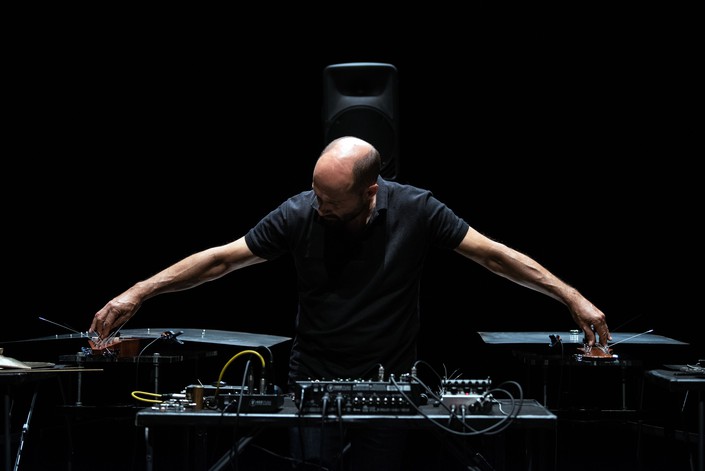 |
| Abdul Moimême |
Alex Buck is a Brazilian composer, performer, music technologist and educator. Currently based in the United States, Buck is recognized for his sophisticated and original aesthetic goals in the fields of acousmatic music and pulse-based improvisation. Born in São Paulo, Alex has specialized in the modality of acousmatic composition. His pieces have received important international awards, including first places in Premio Destellos International Electroacoustic Composition Contest (2022), Prix Métamorphoses (BE 2020), MusicWorks Magazine Electronic Music Composition Contest (2019), and Musica Nova Electroacoustic Music Competition (2019). As a distinguished drummer, Buck has performed alongside important Brazilian musicians including Dominguinhos, Arismar do Espírito Santo, Naylor Proveta, Sandro Haick, Hamilton de Holanda, Mestrinho, Michael Pipoquinha among many others. Alex holds a doctorate in musical arts (DMA) from the California Institute of the Arts (USA) where he studied with saxophonist Steve Lehman, and a master's degree in electroacoustic composition from the Institute of Arts at UNESP (BR), and had as his mentor the composer Flo Menezes.
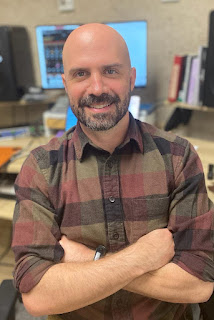 |
| Alex Buck |
Ana Matias is a researcher at the Centre for Marine and Environmental Research (CIMA), from Universidade do Algarve. She has a Geology Degree, a MSc degree in Coastal and Marine Studies, a PhD in Marine Geology, and a MSc degree in Science Communication. Her main research area was coastal geological processes, with participation and coordination of projects that covered topics such as dune vulnerability, artificial dune nourishment, barrier overwash, and evolution and resilience of barrier islands. Currently, A. Matias main focus is transdisciplinary research on Geoscience, Art, and Communication. She coordinated the science & art projects “The Sea Rolls the Sand” (2017, coastal science & dance), “Embodying Memories” (2019, neuroscience & visual art), and Rescue|Search (2020, marine science & photography). A. Matias has been working in a number of projects of science & art, social inclusion & art, and social inclusion & science, particularly with senior citizens.
Astrid Rieder works as an international trans-artist. For over 20 years, Astrid has followed an ideal of interaction between art forms of music and drawing. This exchange between music and drawing leads to an intensified aesthetic experience for both performers and the public. He currently performs monthly at the trans-Art event series at his studio in Wals, Salzburg. In collaboration with a musician (different in each performance), he creates a musical graphic composition in a 40-minute trans-art performance. The work consists of three parts: the drawing, the recorded music, and the video documentary.
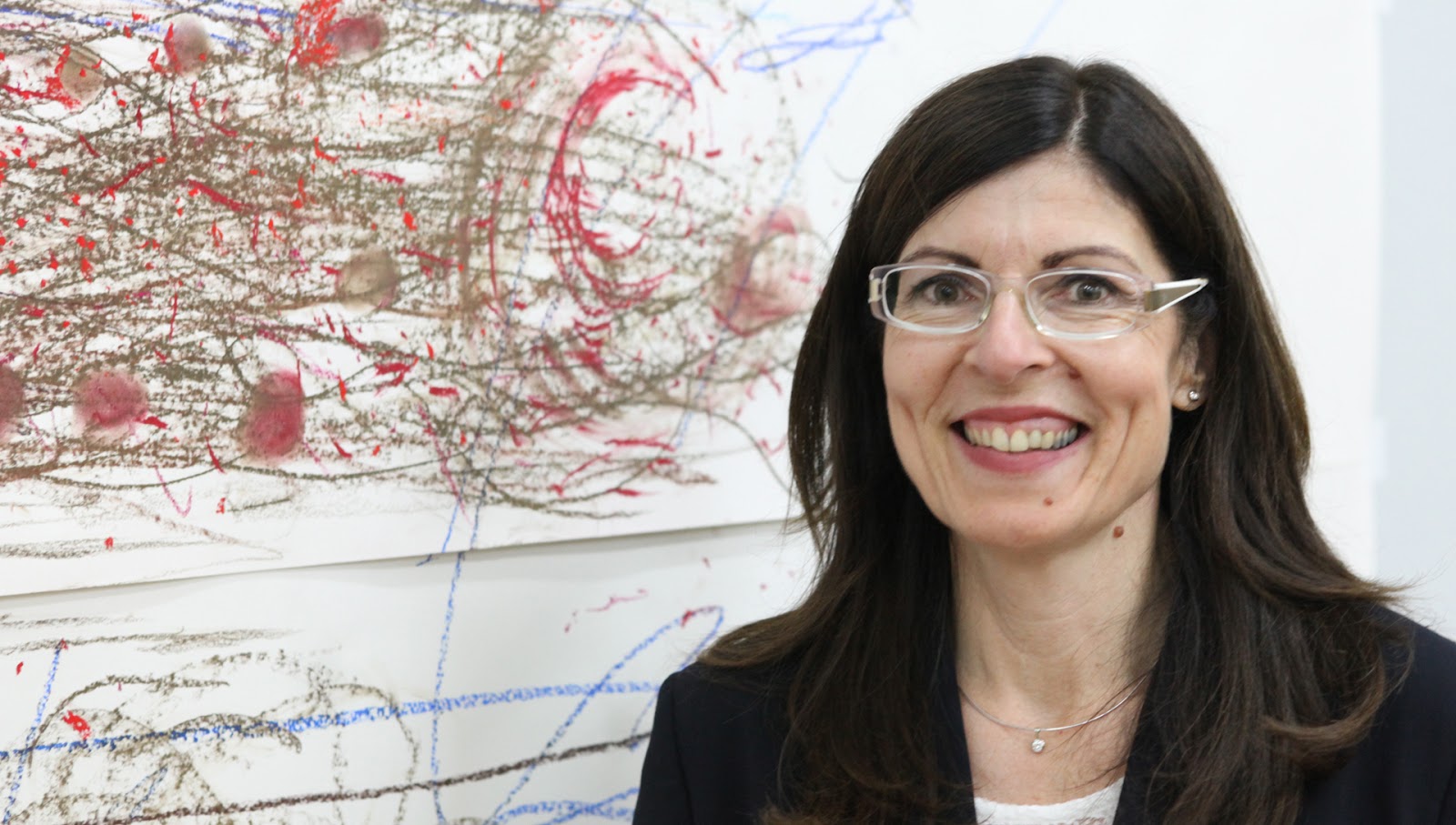 |
| Astrid Rieder |
Carlos Caires is a Lisbon-based composer of music for solo, chamber groups, medium and large orchestra, most works featuring tape or live electronics. He is a full-time professor at the Escola Superior de Musica de Lisboa and a researcher at CESEM (Centro de Estudos de Sociologia e Estética Musical) and CESEM-IPL branch coordinator. He is the recipient of Composition awards such as the Joly Braga Santos Prize in 1994, the Claudio Carneyro Prize in 1996 and the ACARTE-Madalena Perdigão Prize in 1998. His main research topics are musical composition, electronic and mixed music. He has published several articles and has developed software in the field of computer assisted composition. His music has been performed in several European countries, in China and in the USA. He holds a Phd in Arts, Philisophie, Esthétique - spécialité musique from Paris VIII University.
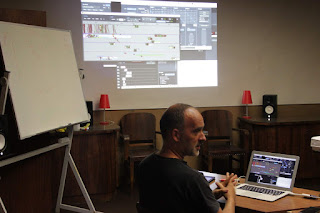 |
| Carlos Caires |
Professor Deborah Power, H factor 49; is an Editor in Chief of General and Comparative Endocrinology, Senior Editorial Board of Scientific Reports and Associate Editor of Aquaculture and Fisheries, the Marine Biological Association Journal and Frontiers Series. Prof Power was awarded a merit professorship for women by the University of Gothenburg, Sweden (2011-2014) and was recently recognized for her contribution to fish aquaculture and was made Doctor Honoris Causa (2012) by the University of Gothenburg. In recognition of her contribution to Biotechnological applications to Aquaculture. Prof Power was recently recruited by the University of Shanghai, China as a visiting Professor and invited as a Distinguished Visiting Professor at BRI, Athlone Institute of Technology, Ireland. In 2022 Prof Power was elected to the Reial Acadèmia de Ciències i Arts de Barcelona (RACAB). Prof Power is a co-leader of the Comparative Endocrinology and Integrative Biology (CEIB) group in CCMAR, PT. Her research covers molecule to ecosystem and work directed at bivalve and fish aquaculture. Prof Power co-ordinates the aquaculture and Biotechnology pilar of CCMAR and has been involved and developed Biotech projects in the Marine domain.
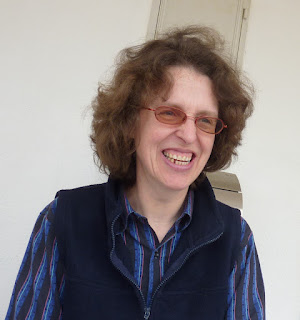 |
| Deborah Power |
Mixed music is a musical genre that has been established since the second half of the 20th century. It can be defined as the junction of the acoustic medium with the electroacoustic medium, more specifically: the combination in performance of one or more acoustic instruments with sounds created, processed or reproduced electronically.
The practice of this laboratory is aimed at developing skills in the performance of mixed music (from repertoire or composed by students specifically for the group), improvisation and experimentation.
Laboratório de Música Mista José Luís Ferreira (Mixed Music Laboratory), formed in 2014, has already had several activities since its creation, of which we highlight concerts and informal auditions at ESML, concerts at the Música Viva festival, artistic residence at O'culto da Ajuda, participation in ESML's Composition Week, participation in concerts of the International Conference "Old is New"- organized by CESEM, Center for the Study of Sociology and Musical Aesthetics in partnership with ESML.
The Mixed Music Lab was created by professors José Luís Ferreira and Carlos Caires and is currently supervised by Jaime Reis and Carlos Caires.
EcoLab is a project of the Mixed Music Laboratory José Luís Ferreira whose objective is, through sound, to raise awareness of environmental issues and promote sustainable attitudes.
Cristóvão Almeida, Débora Coquim, Fábio Chicotio and Ricardo Almeida
 |
| EcoLab |
Composer Elainie Lillios creates works that reflect her fascination with listening, sound, space, time, immersion, and anecdote. Her compositions include stereo, multi-channel, and Ambisonic fixed media works, instrument(s) with live electronics, collaborative experimental audio/visual animations, and installations. Her work has been recognized internationally and nationally through awards, grants, commissions, performances, and CD publications. Elainie serves as Director of Composition Activities for SPLICE (www.splicemusic.org) and as Professor of Creative Arts Excellence at Bowling Green State University in Ohio (USA).
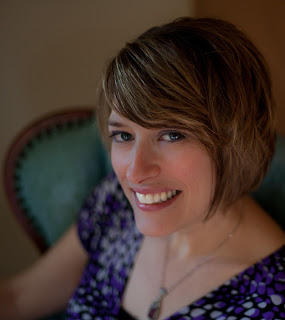 |
| Elainie Lillios |
Eléonore Bak, after apprenticeship of weaving techniques as well as a brief but outstanding experience in stage scenography, she studied at academy for art & design in Colone [D] (1981-85). In 1985 and after studies in CIRM, (International Centre for musical research) and an artistic residency in Villa Arson, both placed in Nice [F], she concentrates her work to sound as material. As her sound work noticed to discretion, as listening is a solitary experience whose potential refinement remains difficult to surround by language because its visual contamination, she becomes interested to mediation. This questioning has brought her closer to scientific research: studies and researches at university of Nice Sophia Antipolis [F] (Master 2 in technologies, cultures and forms of sociability’s, 2001); ACROE lab INP, National Institute for Polytechnics, Grenoble [F] (non-linear theory and physical models, 2002); the smart room of Centrale Supélec, Metz [F] (wave-field synthesis, 2002-14); National High school for architecture in Grenoble [F] (her doctorship (2010-2016) Reside in the un viewed, kinds of sound visualizations, handled on sharing of sound ambiances and discrete phenomenon’s). This artist, PHD in architecture and associate searcher of CRESSON & UMR AAU - CNRS 1563 - ÉNSAs Grenoble & Nantes [F], teaches since 1994 in Art schools and in the last seventeen years in ÉSAL, École supérieure d’art de Lorraine [F], where she founded the sound lab L.A.R.S.
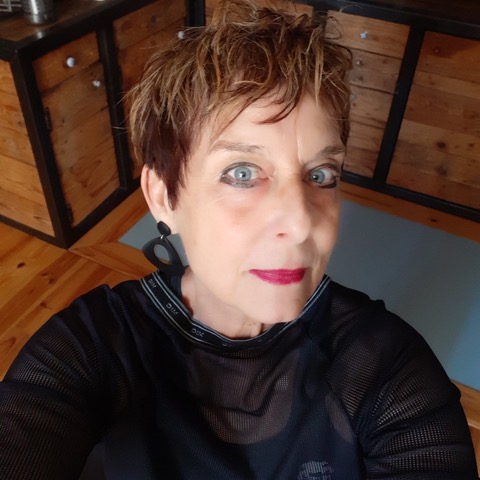 |
| Eléonore Bak |
Inés Wickmann was born in Bogota, Colombia. She graduated from Universidad Javeriana in Interior Design and in Plastic Art at Universidad National, Bogota. Later on, she earned a Master in visual Arts and New Media at the Université du Québec à Montreal (UQAM), Canada. While She studied music and created the program "Sonidos Contemporáneos" or the Universidad Nacional radio station. Her production started with paintings and evolved towards tridimensional objects and video installations. She has participated in numerous individual and collective expositions in Colombia, Mexico, Canada and France. Her videos have been displayed at various international festivals. Her works have their origins in a large inventory of images and "objets trouvés" during her different travels. In her multidisciplinary practice, her reflections move around the threads of time, memory, the disappearance and the identity. Arising from her interest in music, the sound element reaches great relevance in her videos; they are the product of collaboration with many electroacoustic music composers. She currently lives and works in France.
 |
| Inés Wickmann |
Francis Dhomont is a french composer born 1926 in Paris. He was motivated by a passion for music and studied composition with Ginette Waldmeier, Charles Koechlin and Nadia Boulanger. After some early experience in the instrumental and vocal repertories, he turned instinctively towards electro-acoustics, that he saw as a formidable domain for the investigation of sound. Dhomont’s interest in composition on tape led him, after settling in Provence with his own studio (1963), to devote himself exclusively to the production of acousmatic works. While his music progressively gained recognition, he strengthened his initial training with a seminar at the GRM (1973-1974) and presided over the festival Musiques multiples at Saint-Rémy-de-Provence. The succeeding decades, during which Francis Dhomont divided his time between Quebec and France, were particularly productive for the composer. An artist in residence at the music faculty of Montreal University where he subsequently taught, he won, in 1981, First Prize at the International Electro-acoustic Music Competition in Bourges. Several state commissions followed together with many distinctions that revealed him to be a composer of consequence. The acousmatic output of Dhomont features some fifty works, including radiophonic productions. His catalogue includes, notably, »Mais laisserons-nous mourir Arianna?« (1979), »Sous le regard d'un soleil noir« (1981), »Points de fuite« (1982), »Chiaroscuro« (1987), »Signé Dyonisos« (1991), »Forêt profonde« (1994-1996) and »À propos de K« (2006).
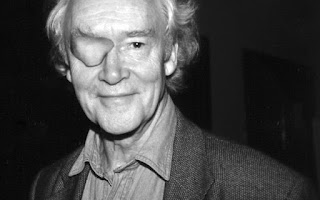 |
| Francis Dhomont |
Ingrid Drese, after a Master's degree in piano, chamber music, music history, musical analysis, enrolled in the electroacoustic composition course at the Royal Conservatory of Music in Brussels, then in Mons, in the class of Annette Vande Gorne. She was awarded the Prix Supérieur in 1998.
She participated in the elaboration and creation of a course in acousmatic music composition at the Academy of Soignies. In addition to teaching piano, she taught acousmatic composition at the Conservatoire Royal de Musique/Art2 in Mons. Her music has won prizes in various competitions and been commissioned to be performed at numerous festivals in Belgium and abroad, as well as on international radio.
Although she mainly composes music for concerts, she likes to experiment with collaborations for stage projects, short films (« Marie T. » and « Hors Chant », Renaud Deputter) and videos (« Paysage avec miroir», Inés Wickmann). Since 2019 she works as an independent composer.
Her music is published by the label empreintes DIGITALes, Montreal: « Interstices », DVD-A monographic, 2010
 |
| Ingrid Drese (@Marc Moniez) |
Isabel Barrote finished her Horticultural Engineering degree (Universidade do Algarve) and worked for the Regional Directorate for Agriculture (Algarve). One year later, in 1991, she began to work as Trainee-Assistant at Universidade do Algarve, where in 2005, she finished her PhD in Plant Physiology and became Assistant Professor. Since then, she has taught several Plant Physiology and Plant Ecophysiology courses and has developed scientific research on the responses of plants to stress while supervising several undergraduates, master, and PhD theses. Her work has been disseminated through participation in conferences and the publication of scientific papers.
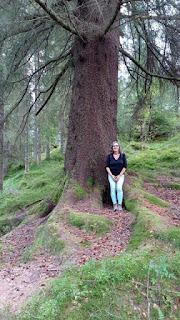 |
| Isabel Barrote |
Jaime Reis is a Portuguese composer who studied with Karlheinz Stockhausen and with Emmanuel Nunes (his Ph.D. co-advisor), after studying Composition and Electronic Music with J.P.Oliveira. He is the founder and artistic director of Festival DME and of Lisboa Incomum. His music, both instrumental and electroacoustic, has been performed in over 20 countries. He has worked with institutions/ensembles such as ZKM, IRCAM, Musik Fabrik, The Vienna Acousmatic Project, Aleph Guitar Quartet, Musiques & Recherches. He is a Professor of composition and electronic music at the Lisbon College of Music (ESML).
retrieved from jaimereis.pt; last update: May 2020
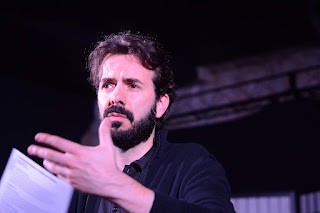 |
| Jaime Reis (@Anna Mouradian) |
Natasha Barrett (1972) is a composer exploring new technologies and experimental approaches to sound in a broad range of contemporary music, including concert works, public space sound-art installations and multimedia interactive music. She is internationally renowned for her electroacoustic and acousmatic music, and use of 3D sound technology in composition. Her work is commissioned and performed throughout the world and has received over 20 international awards including the Nordic Council Music Prize, the Giga-Hertz Award (Germany), five first prizes and the Euphonie D'Or in the Bourges International Electroacoustic Music Awards (France), two first prizes in the International Rostrum for electroacoustic music and most recently the Thomas Seelig Fixed Media Award for 2023. She collaborates with performers, visual artists, architects and scientists and is also active in performance, education and research.
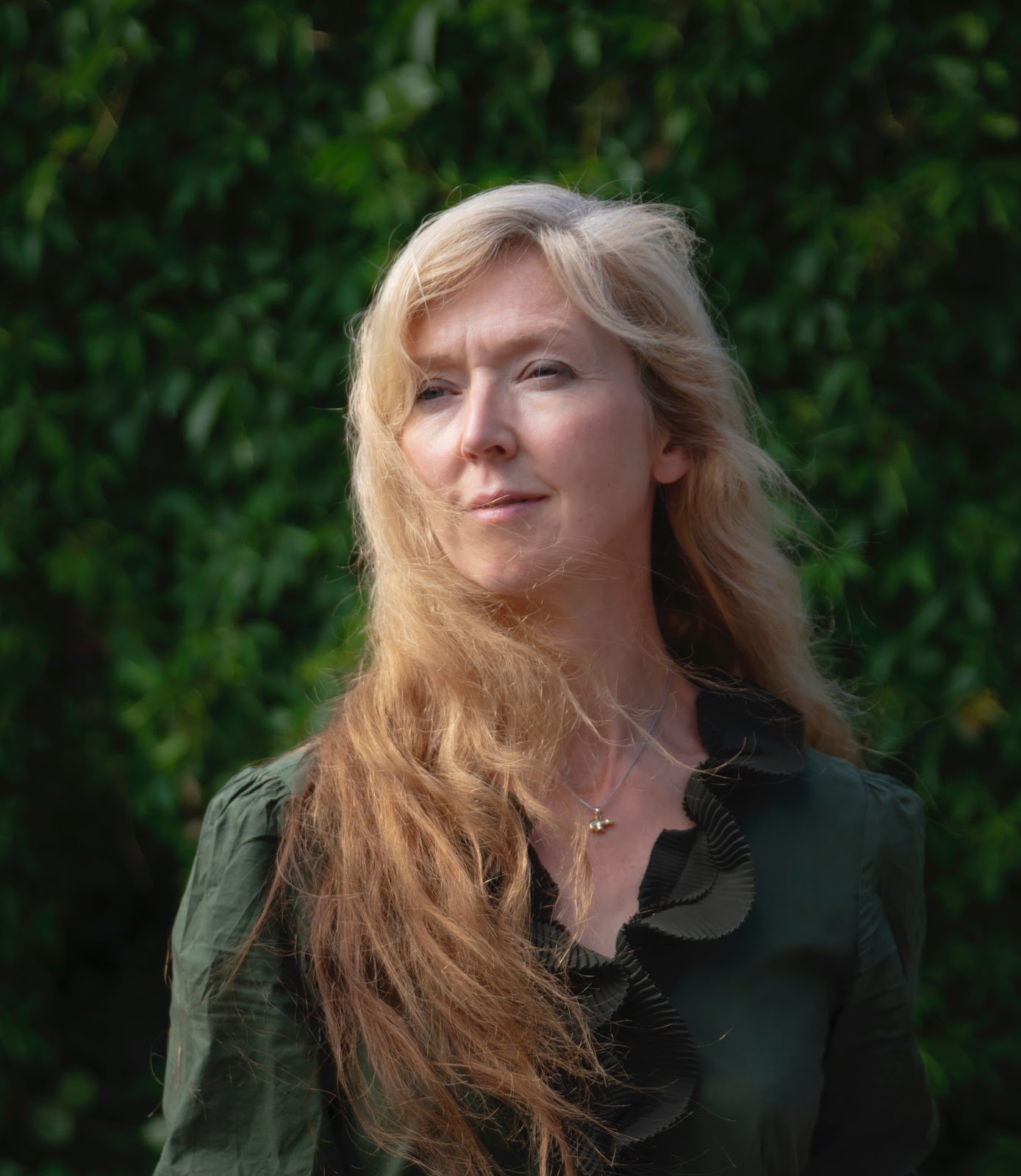 |
| Natasha Barrett |
Paulo Martel received a Doctorate in Computational Biochemistry from the New University of Lisbon, after spending 4 years in Denmark and Norway doing research work on Protein Molecular Modelling, Simulation and Visualization. He is currently an Assistant Professor at the University of the Algarve, where he teaches Bioinformatics, Molecular Modelling and Structural Biochemistry. His research interests are mainly Biomolecular Modelling, Computational Drug Design and Molecular Visualization. |
Ricardo Almeida (Lisbon, 2000) studied classical guitar at D.Dinis’ Music Conservatorium, while simultaneously studying jazz at the same establishment. He did his bachelor’s degree in composition at Lisbon Superior School of Music, where he studied with Luís Tinoco, João Madureira and Carlos Caires. Presently he is doing his Master in Music in the same establishment, guided by the composer Carlos Caires. Concurrently he is doing his Master in Music Education at University of Evora with the guidance of composer and conductor Pedro Amaral. He participated in masterclasses and workshops with composers such as Panayiotis Kokoras, François Bayle, Mario Mary, Robert Normandeu, Thomas Adès, Kaija Saariaho, Mario Pagotto, Annette Vande Gorne, amongst others. He is the artistic director of the cultural institution “Zarambel” where he manages various musical projects with the intent of creating and modernizing new repertoire, such as “Vibrações Ensemble” and “Bluesa Jazz Orchestra”. As a performer, he integrated multiple groups of improvised music like Texturas Ensemble, Eco Lab, Compota, and various jazz bands utilizing live electronics or electric guitar.
Sofia Nunes discovered photography when she was offered her first camera, a 35mm point-and-shoot, at the age of 8. From that moment on, she found the perfect way to create a record of her daily life. The charm for the sciences led her to graduate in Biomedical Engineering, by the NOVA University of Lisbon FCT, with a passage by the Université René Descartes, ParisV, having afterwards post-graduated in Information Management and Healthcare Business Intelligence, by NOVA IMS. It is in Évora that his first incursions into cinema appear, which would translate into the art direction of a set of short films (2017 A Língua - nominated for the Sophia Awards, 2014 Mercurius Health, 2013 O Cheiro das velas, 2012 A Linha) and in the integration of other teams of this nature (2019 Up Stream, 2013 Otto e 2013 Te dedico). This experience rekindled her desire to know more about interior design, which led her to take a specialization in the area, at the Lisbon School of Design. In 2018 she took the Digital Photography course at the Portuguese Institute of Photography. Since then, she began to create photographic series, where she works on themes that disturb and challenge her, she participated in events, collaborated in the IPO 2018 yearbook and has photographed musicians, including Jaime Reis and Mariana Vieira, which connects her to her activity in music (having done training at the Biblioteca Operária Oeirense and at the Luiz Villas-Boas Jazz School - Hot Clube de Portugal), a field to which she dedicates herself in parallel to photography.
November 12th, 2022
Workshop with Isabel Barrote
spatialization by Jaime Reis
November 13th, 2022
Workshop with Eléonore Bak (CRESSON, France)
Conference with Eléonore Bak
Conference with Astrid Rieder
Multidisciplinary Concert
EcoLab / Laboratório de Música Mista José Luís Ferreira ESML
Abdul Moimême and Astrid Rieder

Permanent exhibition
Carlos Caires, Sofia Nunes and Caio Rodrigues



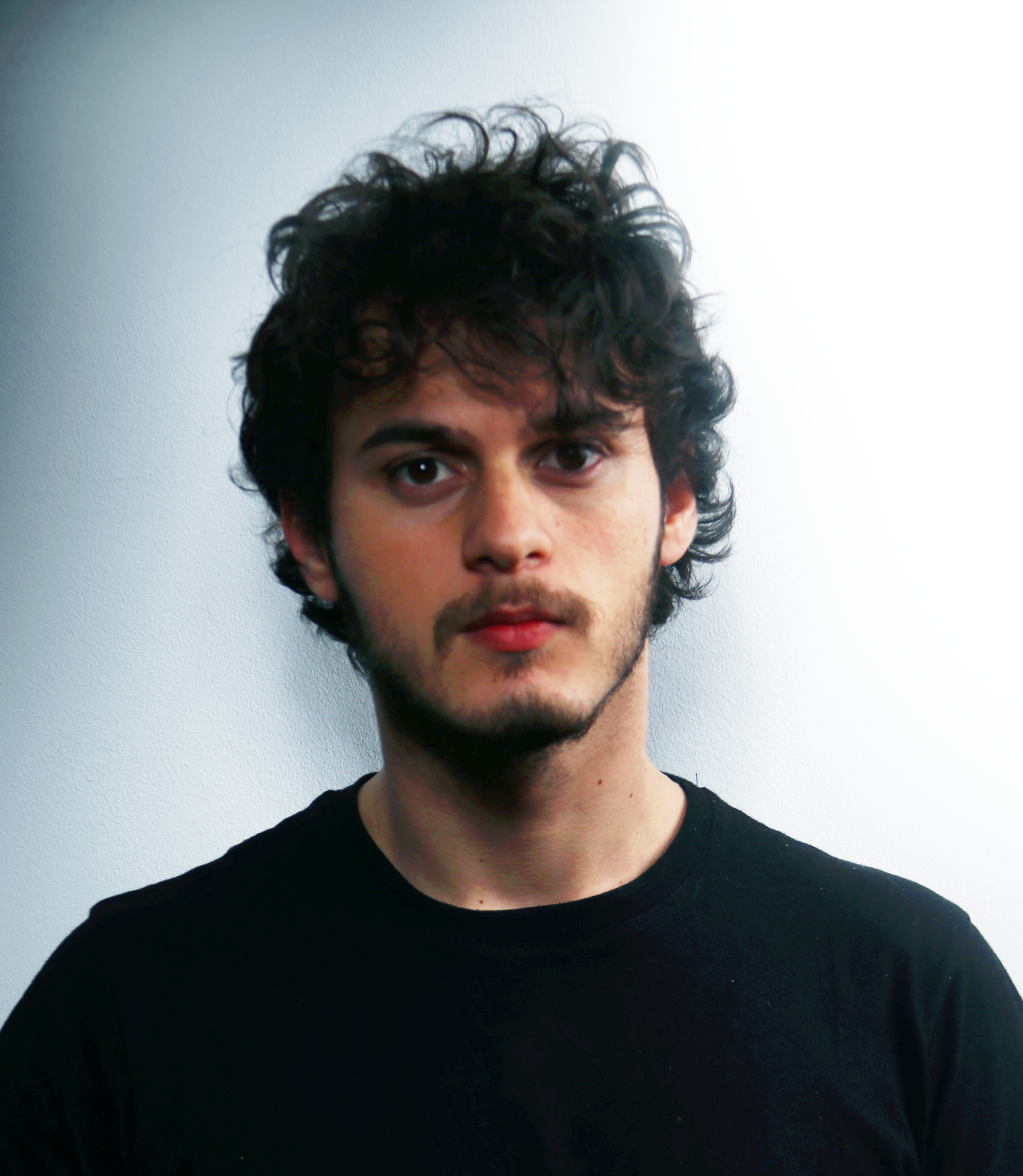
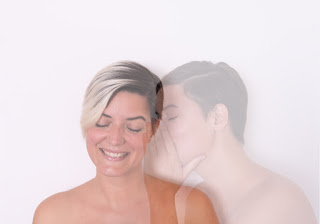
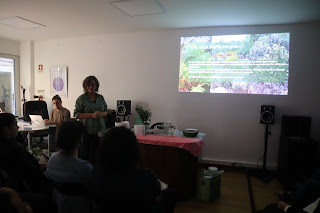
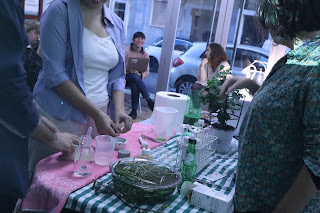
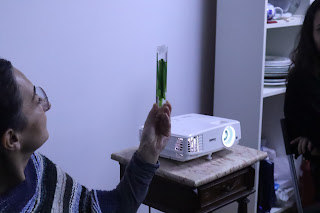
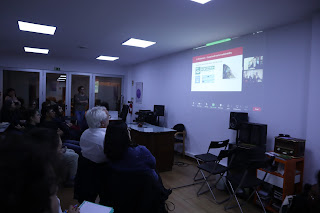
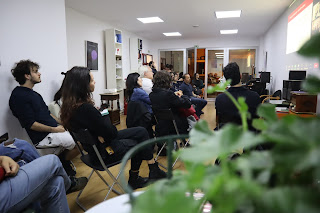
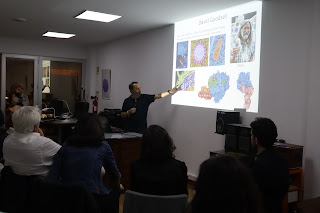

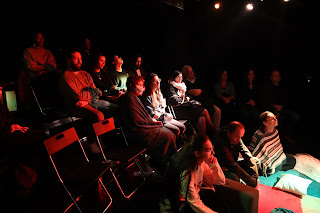
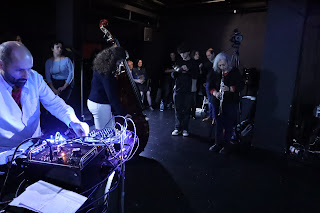
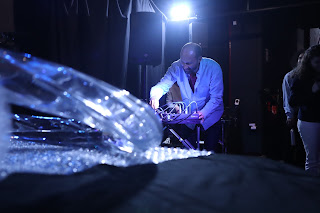
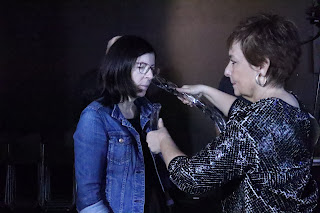

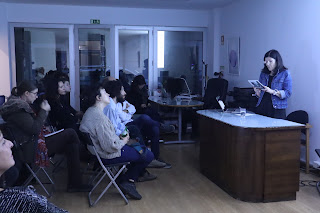
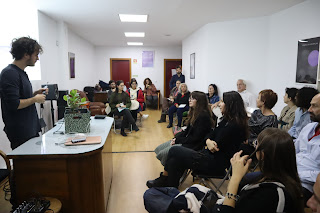
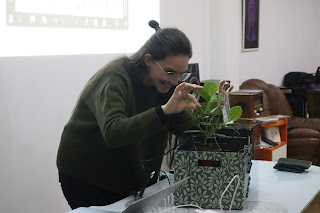
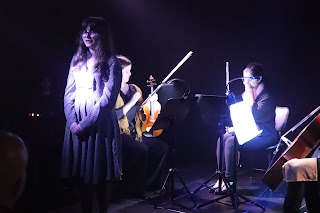
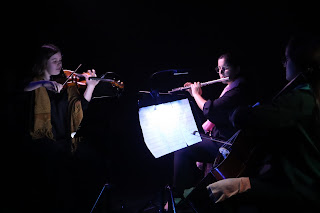
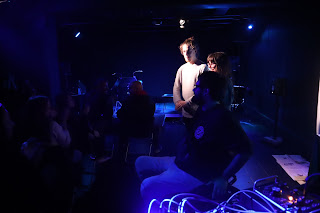
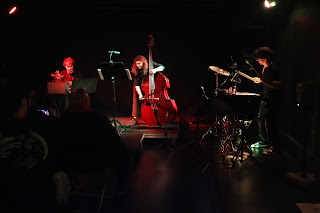
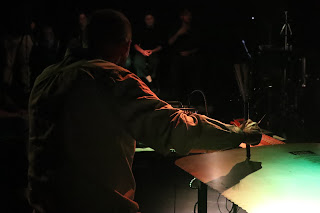
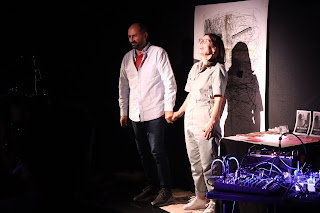
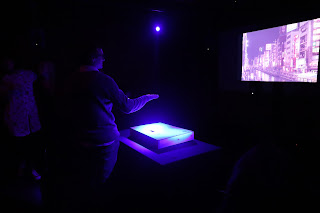


Comentários